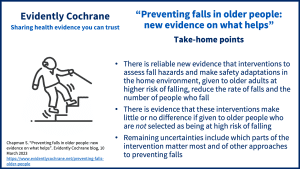Sarah Chapman from Cochrane UK shares new evidence on what can be done to reduce falls in older people at home by assessing hazards and making adaptations to the home environment and, importantly, who is likely to benefit most from these.
Blog updated 20 November 2023 to include the new review on CBT with or without exercise for reducing fear of falling.
Take-home points

Many of us worry about the riskA way of expressing the chance of an event taking place, expressed as the number of events divided by the total number of observations or people. It can be stated as ‘the chance of falling were one in four’ (1/4 = 25%). This measure is good no matter the incidence of events i.e. common or infrequent. of older friends or family members having a fall, and the (often) awful consequences of that.
If you’re an older person, this might be something you worry about for yourself – and maybe that limits what you do. It’s a reasonable fear. Falls are so common (in one year, a third of people aged over 65 and living at home will fall, and half of people aged over 80) and one in three falls happen at home. In an ageing populationThe group of people being studied. Populations may be defined by any characteristics e.g. where they live, age group, certain diseases., this is a growing problem and, with the current pressures on NHS resources, falls prevention feels more important than ever.
Whilst there are many things that contribute to falls, environmental factors are often at work. Among my own older relatives, a cat, a shower tray and a coffee table have all caused falls. But we want our cats and our coffee tables, so what’s to be done? I feel the answer probably doesn’t lie in adopting the shuffling gait my grandmother used to nudge the cat along ahead of her as it tried to wind around her ankles.
However, new evidence from Cochrane does have some answers. The systematic review Environmental interventions for preventing falls in older people living in the community (published March 2023) brings together the best available evidence on this topic, drawing on 22 studies with almost 8500 older people (average age 78). While it highlights things we still don’t know, it also gives us reliable evidence that there are things that help.
Reducing hazards in the home – big gains for people at higher risk of falls
Fourteen of the studies in the review looked at tackling fall hazards in the home. In most of these, there was one home visit (often by an occupational therapist) to assess fall hazards, raise awareness of risks, problem-solve together and make modifications as necessary – things like adding grab rails, improving lighting, putting non-slip strips on steps and removing clutter.
The review authors found reliable (high-certaintyThe certainty (or quality) of evidence is the extent to which we can be confident that what the research tells us about a particular treatment effect is likely to be accurate. Concerns about factors such as bias can reduce the certainty of the evidence. Evidence may be of high certainty; moderate certainty; low certainty or very-low certainty. Cochrane has adopted the GRADE approach (Grading of Recommendations Assessment, Development and Evaluation) for assessing certainty (or quality) of evidence. Find out more here: https://training.cochrane.org/grade-approach) evidence that, among people at higher risk of falling, these kinds of measures:
- reduce the number of falls by 38%
- probably also reduce the number of people who fall once or more by just over a quarter.
Those at higher risk include those who have fallen in the past year, have been in hospital recently, or who need help with everyday activities.
When the review authors looked at the effect of these measures in older people not at higher risk of falling, they found they make little or no difference.
The evidence doesn’t tell us whether they make any difference to the number of people breaking a bone or needing medical attention or hospitalisation because of falls.
Uncertainty about other measures to reduce falls
The review authors found only limited evidence on other measures, so we still don’t know with any certainty about the impact of assistive devices such as special footwear, or improving vision, or home modifications designed to help people be independent in doing everyday tasks, or educating people about fall hazards.
Since this review, a new Cochrane ReviewCochrane Reviews are systematic reviews. In systematic reviews we search for and summarize studies that answer a specific research question (e.g. is paracetamol effective and safe for treating back pain?). The studies are identified, assessed, and summarized by using a systematic and predefined approach. They inform recommendations for healthcare and research. has been published on Cognitive behavioural therapy (CBT) with and without exercise to reduce fear of falling in older people living in the community (November 2023). Whilst the evidence suggests that CBT with and without exercise probably reduces fear of falling in this population, the effect is small, and it’s unclear whether people have fewer falls after this interventionA treatment, procedure or programme of health care that has the potential to change the course of events of a healthcare condition. Examples include a drug, surgery, exercise or counselling. . It’s a big shortcoming in the studies included in the review that none looked at whether there were any harms caused by CBT, with and without exercise, so let’s hope future research looks at that important aspect.
Getting closer to understanding how to reduce falls
The evidence in this review can encourage us to do things to make our homes safer that don’t entail getting rid of the cat or the coffee table. It may also help to direct resources where they are most needed, establishing the benefit of assessing hazards and making safetyRefers to serious adverse effects, such as those that threaten life, require or prolong hospitalization, result in permanent disability, or cause birth defects. adaptations to the home environment for those older people at high risk of falling.
The other story here is of the evolution of research in falls prevention, which is narrowing over time, refining the questions researchers are asking and getting us closer to understanding which interventions work and what components are important, how they should be delivered and who should be given them. The review authors give some detailed suggestions for future research and highlight the importance of studies reporting any harms from environmental changes.
References:
Clemson L, Stark S, Pighills AC, Fairhall NJ, Lamb SE, Ali J, Sherrington C. Environmental interventions for preventing falls in older people living in the community. Cochrane Database of Systematic ReviewsIn systematic reviews we search for and summarize studies that answer a specific research question (e.g. is paracetamol effective and safe for treating back pain?). The studies are identified, assessed, and summarized by using a systematic and predefined approach. They inform recommendations for healthcare and research. 2023, Issue 3. Art. No.: CD013258. DOI: 10.1002/14651858.CD013258.pub2.
Related Cochrane Editorial:
Lewis SR, Griffin XL. Preventing falls in older people: the evidence for environmental interventions and why history matters. Cochrane Database of Systematic Reviews 2023;(3):ED000162.
Lenouvel E, Ullrich P, Siemens W, Dallmeier D, Denkinger M, Kienle G, Zijlstra GA, Hauer K, Klöppel S. Cognitive behavioural therapy (CBT) with and without exercise to reduce fear of falling in older people living in the community. Cochrane Database of Systematic Reviews 2023, Issue 11. Art. No.: CD014666. DOI: 10.1002/14651858.CD014666.pub2.
Join in the conversation on Twitter with @CochraneUK @SarahChapman30 or leave a comment on the blog.
Please note, we cannot give specific medical advice and do not publish comments that link to individual pages requesting donations or to commercial sites, or appear to endorse commercial products. We welcome diverse views and encourage discussion but we ask that comments are respectful and reserve the right to not publish any we consider offensive. Cochrane UK does not fact-check – or endorse – readers’ comments, including any treatments mentioned.
Sarah Chapman has nothing to disclose.

